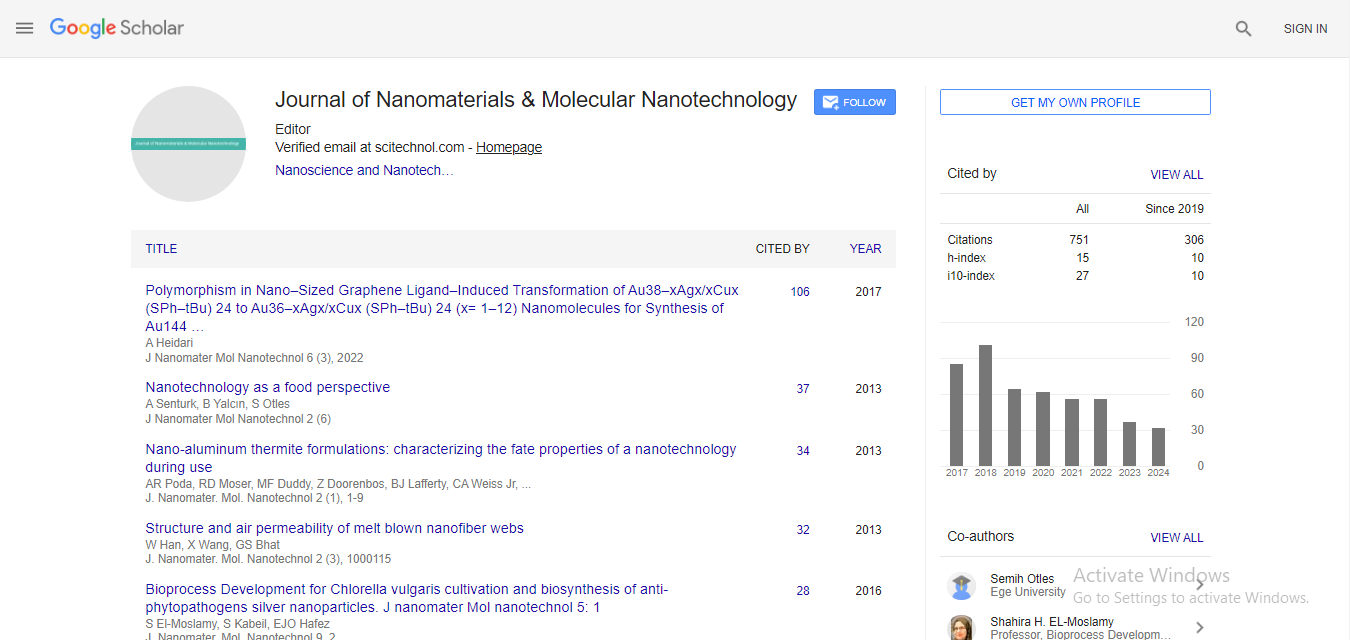Towards new synthesis of Graphene-CNTs hybrid materials
Jerzy P. Lukaszewicz, Anna Ilnicka, Piotr Kamedulski, Małgorzata Skorupska
Nicoulaus Copernicus University, Poland
: J Nanomater Mol Nanotechnol
Abstract
The current state-of-the-art in the synthesis in the area of CNTs’ synthesis involves three basic manufacturing scenarios: (i) chemical vapor deposition, (ii) electric arc discharge and (iii) laser ablation. These three general approaches since they were established in the nineties of XX Century still dominate in the literature. Numerous modifications of the primary synthesis concepts were introduced in to the practice over the years passed after the primary announcements. However, the proposed modifications have not revolutionized the synthesis of CNTs which remains expensive and moderately effective. The mechanism of CNTs formation in these three general methods exploits the phenomenon of thermally induced homogenous atomization of precursors transferring carbon atom radicals from the precursor to the gas phase as depicted in figure 1 below (left). The key point of all standard CNT manufacturing methods is the existence of extremely dissociative conditions at electric discharge, laser ablated spot and/or in CVD furnace. Up to date no attention has been spot on experimental methods which do not involve hemolytic atomization of precursor but rely on a direct phase transition of a solid carbon-rich precursor to CNTs. Authors have discovered that some solid polymers can be directly transformed to CNTs by a plain heat-treatment (in the presence of salts of alkali earth metals) which is resembling a typical carbonization procedure applied for active carbon manufacturing from organic matter. The direct phase transition of a polymer into CNTs proceeds in moderate temperature conditions like 600-700ºC lasting up to 1-2 hours. The polymer sort, heating rate as well the presence of a plain catalyst seem to play a crucial role. The method is useful for growing of thin nanotubes on the other carbon substrates like exfoliated graphene flaks or the surface of ordinary activated carbons as depicted in figure 1 (below). Recent Publications 1. Ilnicka A, Lukaszewicz JP, Shimanoe K, Yuasa M (2018) Urea treatment of nitrogen-doped carbon leads to enhanced performance for the oxygen reduction reaction. Journal of Materials Research 33:1612-1624. 2. Ilnicka A, Lukaszewicz JP (2018) Marine and freshwater feedstocks as a precursor for nitrogen-containing carbons: A review. Marine Drugs 16:142-191. 3. Leżańska M, Olejniczak A, Ã…Âukaszewicz JP (2018) Hierarchical porous carbon templated with silica spheres of a diameter of 14 nm from pure chitosan or a chitosan/ZnCl2 solution. Journal of Porous Materials :1-16. 4. Kamedulski P, Kaczmarek-Kedziera A, Lukaszewicz JP (2018) Influence of intermolecular interactions on the properties of carbon nanotubes. Bulletin of Materials Science 41:76-81. 5. Lezanska M, Olejniczak A, Rokicinska A, Kustrowski P, Lukaszewicz JP (2017) Type A and B gelatin as precursors of silica-templated active porous carbon with a specified number of nitrogen- and oxygen-containing functionalities. Materials Express 7:123-133.
Biography
Jerzy P. Lukaszewicz DSc has his expertise in the synthesis and characterization of carbon-based materials including activated carbons, nitrogen-rich activated carbons, carbon films for chemical sensors, 3D structured graphene, carbon nanotubes. Moreover, he got an expertise in waste rubber utilization by pyrolysis and dry distillation of wood. JP Lukaszewicz is an evaluator of R&D project submitted to several national and international granting institutions. Recently his research activity is focused on electrochemical applications of nanostructured carbon materials. JP Lukaszewicz cooperates with research groups from Korea, Japan, Kuwait and Russia.
E-mail: jerzy_lukaszewicz@o2.pl
 Spanish
Spanish  Chinese
Chinese  Russian
Russian  German
German  French
French  Japanese
Japanese  Portuguese
Portuguese  Hindi
Hindi 



